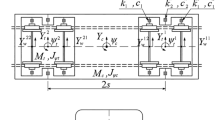Abstract
Based on the explicit time-domain method, an efficient analysis algorithm is developed for the random vibration analysis of the coupled vehicle–bridge system with local nonlinear components. In this work, the coupled vehicle–bridge system is divided into two subsystems, including the linear bridge subsystem and the nonlinear vehicle subsystem. Firstly, using the equivalent linearization technique, the equivalent linearized subsystem is constructed for the vehicle subsystem with the hysteretic suspension spring at a given time instant. Then, the explicit expressions of the responses of the linearized vehicle subsystem and the linear bridge subsystem are constructed corresponding to contact forces, respectively. Further, the explicit expression of the contact forces is derived in consideration of the compatibility condition. Lastly, the dimension-reduction vibration analysis for the equivalent linearized coupled vehicle–bridge system can be carried out based on the explicit time-domain method. The numerical example about a coupled vehicle–bridge system under the random irregular excitation is investigated, and the results indicate that the proposed approach is of feasibility.

















Similar content being viewed by others
References
Esmailzadeh, E., Jalili, N.: Vehicle-passenger-structure interaction of uniform bridges traversed by moving vehicles. J. Sound Vib. 260, 611–635 (2003)
Charikleia, D.-S., Elias, G.-D.: Additional damping effect on bridges because of vehicle–bridge interaction. J. Sound Vib. 476, 115294 (2020)
Bao, Y.-L., Zhai, W.-M., Cai, C.-B., Zhu, S.-Y., Li, Y.-L.: Dynamic interaction analysis of suspended monorail vehicle and bridge subject to crosswinds. Mech. Sys. Signal Process. 156, 107707 (2021)
Shao, Y.-F., Brownjohn, J.-M.-W., Miao, C.-Q., Wang, M.-M.: A precise time-integration linear vehicle–bridge interaction method and dynamic sensitivity analysis. Structures 33, 4596–4603 (2021)
Li, J.-Q., Leng, X.-L., Fang, T.: Evolutionary random response problem of a coupled vehicle–bridge system. Arch. Appl. Mech. 72(6/7), 536–544 (2002)
Pablo, A., Zhang, N., José, M.-G., He, X., Miguel, Á.-A., Javier, O.: Consideration of nonlinear wheel-rail contact forces for dynamic vehicle–bridge interaction in high-speed railways. J. Sound Vib. 332(5), 1231–1251 (2013)
Zhang, Z., Zhang, Y., Lin, J.-H., Zhao, Y., Howson, W.-P., Williams, F.-W.: Random vibration of a train traversing a bridge subjected to traveling seismic waves. Eng. Struct. 33(12), 3546–3558 (2011)
Mao, J.-F., Yu, Z.-W., Xiao, Y.-J., Jin, C., Bai, Y.: Random dynamic analysis of a train-bridge coupled system involving random system parameters based on probability density evolution method. Probab. Eng. Mech. 46, 48–61 (2016)
Hoai, H., Mayuko, N.: Evaluation of dynamic responses of bridges considering traffic flow and surface roughness. Eng. Struct. 225, 111256 (2020)
Yu, H.-L., Wang, B., Xia, C.-P., Gao, Z.-Y., Li, Y.-L.: Efficient non-stationary random vibration analysis of vehicle–bridge system based on an improved explicit time-domain method. Eng. Struct. 231, 111786 (2021)
Zhu, W.-Q.: Nonlinear stochastic dynamic and control in Hamiltonian formulation. Appl. Mech. Rev. 59(4), 230–245 (2006)
Zeng, Y., Zhu, W.-Q.: Stochastic averaging of quasi-linear systems driven by Poisson white noise. Probab. Eng. Mech. 25(1), 99–107 (2010)
Crandall, S.-H.: Non-Gaussian closure for random vibration of nonlinear oscillator. Int. J. Non-Linear Mech. 15(4–5), 303–313 (1980)
Crandall, S.-H.: A half-century of stochastic equivalent linearization. Struct. Control Health Monit. 13, 27–40 (2006)
Proppe, C., Pradlwarter, H.-J., Schuëller, G.-I.: Equivalent linearization and Monte Carlo simulation in stochastic dynamics. Probab. Eng. Mech. 18(1), 1–15 (2003)
Zhang, J.-J., Klaus, K.: Statistical linearization of wheel/rail contact nonlinearities for investigation of curving behaviour with random track irregularities. Veh. Syst. Dyn. 25, 731–745 (1996)
Jin, Z.-B., Li, X.-Z., Zhu, Y., Qiang, S.-Z.: Random vibration analysis of nonlinear vehicle–bridge dynamic interactions. J. China Railw. Soc. 39(9), 109–116 (2017). (in Chinese)
Lu, F., Lin, J.-H., Kennedy, D., Williams, F.-W.: An algorithm to study non-stationary random vibrations of vehicle–bridge systems. Comput. Struct. 87(3–4), 177–185 (2009)
Su, C., Xu, R.: Random vibration analysis of structures by a time-domain explicit formulation method. Struct. Eng. Mech. 52(2), 239–260 (2014)
Su, C., Huang, H., Ma, H.-T.: Fast Equivalent linearization method for nonlinear structures under nonstationary random excitations. J. Eng. Mech. 142(8), 04016049 (2016)
Su, C., Xian, J.-H., Huang, H.: An iterative equivalent linearization approach for stochastic sensitivity analysis of hysteretic systems under seismic excitations based on explicit time-domain method. Comput. Struct. 242(1), 160396 (2020)
Su, C., Sang, X.-L., Huang, H.: On physical Mechanism and probabilistic evolution in random vibration of structures. In: Symposium on Reliability of Engineering System, Hangzhou (2015)
Wen, Y.-K.: Method for random vibration of hysteretic systems. J. Eng. Mech. Div. 102(2), 249–263 (1976)
Roberts, J.-B., Spanos, P.-D.: Random Vibration and Statistical Linearization. Dover Publication, New York (2003)
Bathe K.-J.: Finite Element Procedures. Englewood Cliffs, Prentice-Hall, NJ (1996)
Su, C., Zhong, C.-Y., Zhou, L.-C.: Random vibration analysis of coupled vehicle–bridge system with the explicit time-domain method. Appl. Math. Mech. 38(1), 99–108 (2017). (in Chinese)
Acknowledgements
The project is funded by the Natural Science Foundation of Guangdong Province, China (Grant No. 2020A1515010611, Grant No. 2021A1515012280).
Author information
Authors and Affiliations
Corresponding authors
Ethics declarations
Conflicts of interest
The authors declare that they have no conflict of interest.
Additional information
The datasets generated during the current study are available from the corresponding author on reasonable request.
Additional information
Publisher's Note
Springer Nature remains neutral with regard to jurisdictional claims in published maps and institutional affiliations.
Rights and permissions
About this article
Cite this article
Huang, H., Zheng, H., Deng, J. et al. Random analysis of coupled vehicle–bridge systems with local nonlinearities based on explicit time-domain method. Nonlinear Dyn 108, 81–95 (2022). https://doi.org/10.1007/s11071-021-07190-9
Received:
Accepted:
Published:
Issue Date:
DOI: https://doi.org/10.1007/s11071-021-07190-9




